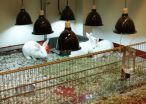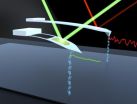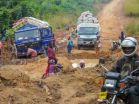(Press-News.org) CHAMPAIGN, Ill. — Rabbits that remain indoors may suffer from a lack of vitamin D, researchers report in a new study. In rabbits kept as pets or used in laboratory studies, the deficiency could lead to dental problems, undermine their cardiovascular health, weaken their immune systems and skew scientific findings.
The study found that regular exposure to artificial ultraviolet B light for two weeks doubled rabbits' serum vitamin D levels – an increase not seen in animals raised in artificial light lacking UVB radiation. Future studies will seek to determine optimal levels of UVB exposure and vitamin D levels in rabbits, guinea pigs, chinchillas and other animals.
A report of the study appears in the American Journal of Veterinary Research.
"We know that vitamin D is important to vertebrates in that it helps with calcium absorption, but it also has been shown to benefit cardiovascular health and immune function," said Mark Mitchell, a University of Illinois veterinary clinical medicine professor, who led the research. "We know of several types of diseases that can develop with vitamin D deficiency. Some of the chronic problems we see are tooth-related."
Other researchers have proposed that low vitamin D plays a role in dental disease in pet rabbits, Mitchell said.
"We are doing tooth trims and managing dental disease in rabbits, chinchillas and guinea pigs on a regular basis," Mitchell said. "Weekly, we see those types of cases in our zoo medicine clinical service. It's something that also is seen across the country and internationally. It's a common problem."
Most laboratory animals and many pet rabbits are not allowed outdoors because of the risks of exposure to predators, parasites and disease, Mitchell said. Windows block most UVB radiation. If the animals don't get sufficient vitamin D from their diet and are never exposed to ultraviolet light, they may become deficient, he said.
"As a clinician, I want to better manage these animals, give them a longer, higher quality of life," Mitchell said.
Vitamin D deficiency also could undermine the validity of studies using rabbits in research to improve animal and human health, he said.
"In human medicine, they're starting to measure vitamin D levels as part of our routine medical exams," he said. "But if we're not doing this with animals that we're using in research, we might be missing a step."
INFORMATION:
Editor's notes: To reach Mark Mitchell, email mmitch@illinois.edu.
The paper, "Effects of Ultraviolet Radiation Produced From Artificial Lights on Serum 25-Hydroxyvitamin D Concentration in Captive Domestic Rabbits (Oryctolagus cuniculi)," is available online and from the U. of I. News Bureau.
Rabbits kept indoors could be vitamin D deficient
2014-04-09
ELSE PRESS RELEASES FROM THIS DATE:
Recycling astronaut urine for energy and drinking water
2014-04-09
On the less glamorous side of space exploration, there's the more practical problem of waste — in particular, what to do with astronaut pee. But rather than ejecting it into space, scientists are developing a new technique that can turn this waste burden into a boon by converting it into fuel and much-needed drinking water. Their report, which could also inspire new ways to treat municipal wastewater, appears in the journal ACS Sustainable Chemistry & Engineering.
Eduardo Nicolau, Carlos R. Cabrera and colleagues point out that human waste on long-term journeys into ...
Can animals really help people in hospitals, aged care?
2014-04-09
While many people have an opinion on whether animals can help to improve wellbeing and care for patients in hospitals, does anyone really know whether there are benefits both for the patients and the animals themselves?
Not according to a team of researchers from the University of Adelaide, which has conducted a worldwide review of all studies looking at the impact of "animal interventions" in healthcare settings for children.
The researchers, from the University's School of Psychology and School of Animal and Veterinary Sciences, have found that despite theories emerging ...
NASA satellite sees Tropical Depression Peipah crawling toward Philippines
2014-04-09
NASA-NOAA's Suomi NPP satellite passed over the remnants of Tropical Depression Peipah on April 9 as the storm slowly approached the Philippines from the east. According to the Joint Typhoon Warning Center, Peipah is now not expected to make landfall in eastern Visayas until April 12.
The Visible Infrared Imaging Radiometer Suite or VIIRS instrument aboard Suomi NPP captured a visible, high-resolution image of the storm as it continued moving through the Philippine Sea. The storm appeared disorganized in the image, and the center was difficult to pinpoint on the visible ...
Promising agents burst through 'superbug' defenses to fight antibiotic resistance
2014-04-09
In the fight against "superbugs," scientists have discovered a class of agents that can make some of the most notorious strains vulnerable to the same antibiotics that they once handily shrugged off. The report on the promising agents called metallopolymers appears in the Journal of the American Chemical Society.
Chuanbing Tang and colleagues note that the antibiotic-resistant bacteria known as MRSA (methicillin-resistant Staphylococcus aureus) is responsible for a significant fraction of the infections that patients acquire in hospitals. According to the Centers for ...
Pharma firms turn attention to hearing loss
2014-04-09
Hearing loss affects 36 million Americans to some degree, often leaving them feeling isolated, but it has received little attention from the pharmaceutical industry — until now. Small firms have brought a handful of potential therapies to the development pipeline, and pharmaceutical heavyweights are taking notice, according to an article in Chemical & Engineering News (C&EN), the weekly magazine of the American Chemical Society.
The story states that the most common cause of hearing loss is loud noise, either from a single event like the bang of a firecracker or from ...
Europeans and biomedical research
2014-04-09
This news release is available in French. The French National Institute of Health and Medical Research (Inserm) is currently the leading biomedical research organisation in Europe, and plays a key role in developing European research. To mark its 50th anniversary, Inserm wanted to assess the perceptions of Europeans regarding biomedical research.
To create this European panorama, Ipsos carried out an Internet survey of over 4,000 Europeans (with 1,001 French, 1,004 German, 1,001 Italians and 1,005 British respondents) from 10 to 23 January 2014. Representative samples ...
No compromises: JILA's short, flexible, reusable AFM probe
2014-04-09
JILA researchers have engineered a short, flexible, reusable probe for the atomic force microscope (AFM) that enables state-of-the-art precision and stability in picoscale force measurements. Shorter, softer and more agile than standard and recently enhanced AFM probes, the JILA tips will benefit nanotechnology and studies of folding and stretching in biomolecules such as proteins and DNA.
An AFM probe is a cantilever, shaped like a tiny diving board with a small, atomic-scale point on the free end. To measure forces at the molecular scale in a liquid, the probe attaches ...
Green is good
2014-04-09
As unlikely as it sounds, green tomatoes may hold the answer to bigger, stronger muscles.
Using a screening method that previously identified a compound in apple peel as a muscle-boosting agent, a team of University of Iowa scientists has now discovered that tomatidine, a compound from green tomatoes, is even more potent for building muscle and protecting against muscle atrophy.
Muscle atrophy, or wasting, is caused by aging and a variety of illnesses and injuries, including cancer, heart failure, and orthopedic injuries, to name a few. It makes people weak and fatigued, ...
The surgical treatment of bilateral benign nodular goiter
2014-04-09
About 100.000 thyroid operations are performed in Germany each year, a large percentage of them for the treatment of benign thyroid disease (euthyroid nodular goiter). In the current issue of Deutsches Ärzteblatt International (Dtsch Arztebl Int 2014; 111 (10): 161-8), Nada Rayes and colleagues suggest a paradigm shift in the treatment of such lesions. The article is accompanied by an editorial by Roland Gärtner.
Radical surgery has become much more common in the past few years and has been motivated by a desire to prevent recurrences. From 2006 to 2008, the percentage ...
One of the last strongholds for Western chimpanzees
2014-04-09
This news release is available in German. When Liberia enters the news it is usually in the context of civil war, economic crisis, poverty or a disease outbreak such as the recent emergence of Ebola in West Africa. Liberia's status as a biodiversity hotspot and the fact that it is home to some of the last viable and threatened wildlife populations in West Africa has received little media attention in the past. This is partly because the many years of violent conflict in Liberia, from 1989 to 1997 and from 2002 to 2003, thwarted efforts of biologists to conduct biological ...





